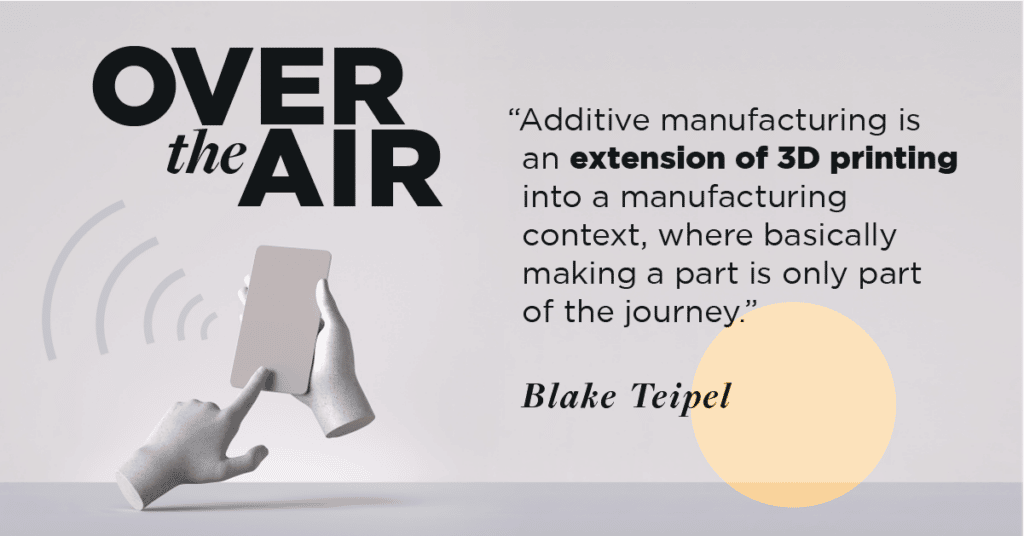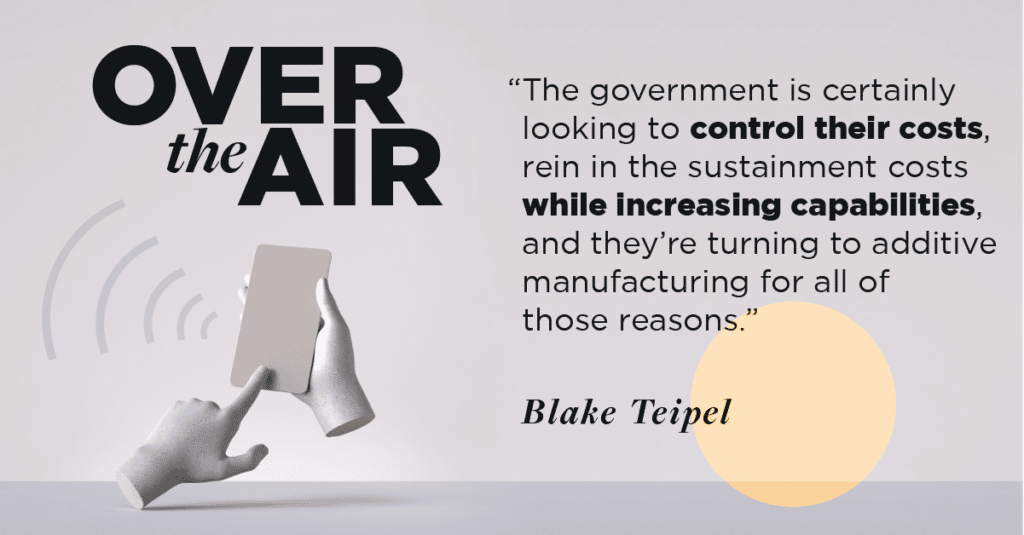Podcast
Episode 14: Star Trek Replicators? How Additive Manufacturing is Changing the Industry
September 14, 2021
31 minutes
We’re a lot closer to having a bona fide Star Trek replicator than you might think.
Sure, we’re not to the point where you can just press a button and a part — or maybe a steak and some Romulan ale — will materialize out of nowhere. However, additive manufacturing has finally matured to such a degree that 3D printing is feasible for manufacturing applications.
Blake Teipel, Co-Founder and CEO at Essentium, shares how additive manufacturing is bringing agility and adaptability to manufacturers and product developers.
We discuss:
- What additive manufacturing is
- Building a team vs finding partners
- Electromagnetic energy and electrically conductive plastics
This post is based on a podcast episode with Blake Teipel, Co-Founder and CEO at Essentium. To hear more interviews like this one, subscribe to Over the Air wherever you listen to podcasts.
Additive Manufacturing is Officially a Thing
There’s been enough information in the media and online, that we all pretty much understand 3D Printing. But what do you know about additive manufacturing?
3D Printing
3D Printing isn’t bringing in the oohs and aahs anymore. It’s widely available, small scale and mostly used to produce figurines or desktop novelties.
Academia depends on it to introduce curious minds to the wonders of modern technology.
Additive Manufacturing

It’s no longer about the little desktop novelty you 3D print to impress your colleagues.
Additive manufacturing is 3D printing on steroids:An object goes through a design process
- A print file is prepared
- The object actually gets printed
- The object is removed from the print bed for cleaning and inspection
- Data is recorded at every step of the way, and afterward.
Manufacturing targets (time, cost, quality) branch out into different metrics that become crucial for constantly improving the additive manufacturing process.
Blake’s excitement is fuelled by 3D printing now reaching the point in its proliferation where it’s industrially relevant. It’s opening a hallway filled with more doors of manufacturing opportunity.
What Does This Have to Do with Essentium?
Essentium’s focus is on mid-range mid-volume manufacturers, many of whom currently use injection molding to produce parts.
Before Essentium: injection molding depends on molds ie. if you don’t have an object mold you can’t produce that object.
After Essentium: you use additive manufacturing to produce any objects you want. You have the corresponding compliant print files, raw materials, and equipment. Your company can change what it manufactures without the delays of sourcing injection molds.
We’re Entering the Age of the Agile Manufacturer
The agile business model is synonymous with SaaS and FinTechs, as far as most of us know.
Additive manufacturing puts previous limitations to shame by enabling manufacturers with record-breaking ability to adapt quickly and at lower costs than ever before.
It’s the ambitious manufacturer’s dream come true.

Hiring for Additive Manufacturing
Implementing the additive manufacturing model presents a blend of challenges from traditional manufacturing, HR, and technology altogether.
Blake sugarcoats nothing and is blatant about both the highs and lows of working with other people, all while doing your best as a leader. Like many other businesses today, he looked for generalists first: people who could do whatever needed to be done, rather than the ones who waited until their specialty fit into the equation.
He needed people who knew a lot about a lot, but the catch with that is when talent walks out the door, talent takes that knowledge out of the business.
Imagine having to completely relearn something as complex as how to use electromagnetic energy inside a 3D printer…
Essentium’s Additive Manufacturing Challenges
Injection molding offers almost similar strength properties for substrates, in all three directions of the 3D object plane. 3D Printing needed to provide the same.
Think of a deck of playing cards. When they’re stacked up, and placed face-down or face-up onto a table, you can’t grab the deck and pull it apart from left to right, or top to bottom (if you view it from above). But you can ‘cut’ the deck.
That Z plane that extrudes the shape upward, for height, is the weakest in 3D printed objects and it presents a unique challenge.
As challenging as it was, you can bet that Blake’s team figured it out and achieved isotropic outputs. They gave it a fancy name, as one does: flash fuse technology.
Achievement unlocked: additive manufacturing became an official production model option.
The ‘Mad Science’ of it All
Like a glue gun, a typical 3D printer emits heat from the printing nozzle where substrate is piped or sprayed out.
Essentium developed what they call a halo: something similar to a rain shower head but for 3D printers, that ‘rains’ electromagnetic energy down onto the previously printed layer of substrate.
That energy is wasted if it’s not coupled with another material. In Essentium’s case, an electrically conductive plastic was selected. You know how most durable plastic containers don’t really heat up in the microwave? They’ve found a way to change that to achieve that isotropic quality of the 3D printed objects their clients produce.
Normally we’d give you a little sneak peek into where things are heading. While Essentium announces new printers over the next few months we know they’ve got something bigger up their sleeves in years to come.
They’re making magic with additive manufacturing, bringing the dream of the agile manufacturer to life. How long before you join the revolution?
Never miss an episode of Over the Air by subscribing wherever you listen to podcasts.

Hosted by: Ryan Prosser
CEO at Very
As Very's CEO, Ryan collaborates daily with product, sales, and marketing to deliver the IoT solutions our clients look for. He is also a champion for our culture, fostering transparency and efficiency across our distributed team.










